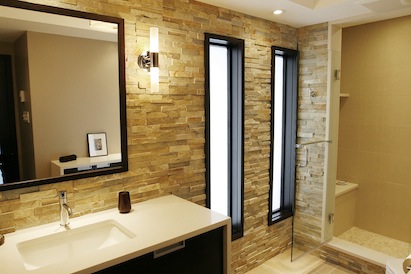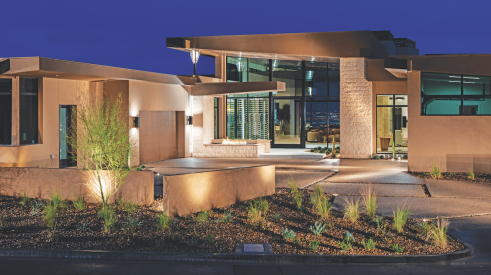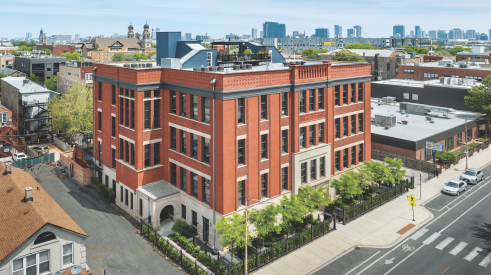Each year, the National Kitchen and Bath Association (NKBA) surveys its members to identify the latest design and specification trends in kitchen and bath design. This year, 350 NKBA members took part in the survey. Here are five emerging bathroom trends they identified. Note that four of the five can apply to kitchens as well.
1. Medicine cabinets

The tried-and-true medicine cabinet had been swept aside in bathroom remodels over the past several years, replaced by decorative wall mirrors. However, as homeowners look for more efficient use of space, most designers are now turning toward medicine cabinets as an effective way to gain additional storage without having to increase the footprint of a room, attenuating the need for separate shelving, cabinetry, or other storage options.
After being specified by 43 percent of NKBA member bathroom designers leading into 2010, medicine cabinets dropped to 36 percent last year. However, as we enter 2012, some 66 percent have recently incorporated a medicine cabinet into a bathroom remodel, according to NKBA.
Source: NKBA Photo: NuTone/courtesy of NKBA
[pagebreak]
2. Transitional over traditional

For the first time since the NKBA began tracking annual design trends, traditional is no longer the most popular type of design. In both the kitchen and the bathroom, transitional is now the most common style. While the traditional style has consistently been used by roughly three quarters of NKBA member designers in both the kitchen and the bath, that figure fell to 58 percent in kitchens and 59 percent in bathrooms this year.
These figures come in just below the transitional style, which is a blend of traditional and contemporary, typified by lines that are simpler than traditional, but a bit more elaborate than contemporary in order to create a modern classic look. Contemporary is the next most common style, up 5 percent to 52 percent in kitchens and up 10 percent to 53 percent in bathrooms from a year ago. Shaker, arts & crafts, and cottage remain the next most frequently used styles, according to NKBA.
Source: NKBA Photo: KraftMaid/courtesy of NKBA
[pagebreak]
3. Solid surfaces

A year ago, the use of solid surfaces was a key trend in the kitchen; this year, it’s an even stronger trend, and one that impacts both the kitchen and the bathroom. In the NKBA’s 2011 Design Trends Survey, the use of solid surfaces in the kitchen jumped from 11 percent to 26 percent from the year earlier. This year, that number has increased again, as solid surfaces have been specified recently by 30 percent of designers for use in kitchens. At the same time, while granite and quartz continue to be the clear No. 1 and No. 2 choices, their popularity has waned just slightly, with granite falling from 91 percent to 87 percent and quartz declining just a bit from 71 percent to 69 percent.
The same pattern holds true in newly remodeled bathrooms, as solid surfaces have over the past year risen from 26 percent to 34 percent, as granite has fallen from 84 percent to 71 percent. Quartz’s popularity has dipped over that time from 56 percent to 53 percent. Marble is currently the third most popular vanity top material at 41 percent, up 3 percent from a year ago. Also notable is the use of glass vanity tops, which has more than doubled over the past two years, from 5 percent heading into 2010 to 11 percent today, according to NKBA.
Source: NKBA Photo: Cosentino/courtesy of NKBA
[pagebreak]
4. Shades of gray

When artfully incorporated into a space, gray color schemes can allow for very attractive, distinguished looks without overpowering a design—the key reason why gray is now used as the backdrop for the NKBA logo. In kitchens, gray was used as the overall color scheme by only 9 percent of designers as we moved into 2010, but that figure nearly doubled (to 17 percent) last year and then nearly doubled again (to 33 percent) this year. Over that time, the use of gray color schemes has risen just as dramatically from 12 percent to 21 percent to 40 percent in bathroom remodels.
Whites and off-whites continue to be the most popular color schemes in the kitchen and bathroom, followed by beiges and bones. Brown is the third most popular color in kitchens and the fourth most popular in bathrooms, just behind gray. In the kitchen, bronzes/terracottas have risen over the past two years from 20 percent to 25 percent to 31 percent, while greens have increased from 18 percent two years ago to 32 percent today. Green was the color trend in bathrooms last year, being specified by 25 percent of designers, and its use has remained exactly the same this year. Blue has emerged as the fifth most popular color in bathrooms, rising from 23 percent to 30 percent, according to NKBA.
Source: NKBA Photo: Benjamin Moore/courtesy of NKBA
[pagebreak]
5. Polished chrome is back

Supplanted by brushed metal finishes in the past, polished chrome is staging a comeback. After being specified by 34 percent of designers in kitchens last year, polished chrome has recently been specified by 52 percent of NKBA member designers in kitchens today. In the bathroom, polished chrome use has increased from 46 percent to 65 percent over the past year. At the same time, polished nickel is up from 17 percent to 25 percent in kitchens and from 28 percent to 32 percent in bathrooms over the past year.
The increased use of polished finishes is clearly coming at the expense of brushed finishes. Over the past two years, brushed nickel is down from 62 percent to 46 percent in kitchens and from 66 percent to 46 percent in bathrooms. Brushed chrome is down from 20 percent to 17 percent over the past year in kitchens, but has increased from 11 percent to 18 percent in bathrooms. Meanwhile, over the past year, satin nickel—which lies between a polished and a brushed finish—is down from 64 percent to 56 percent in the kitchen and from 57 percent to 52 percent in the bathroom.
Only stainless steel has managed to clearly buck the trend away from brushed finishes, as it rose slightly from 46 percent to 50 percent in the kitchen and increased significantly from 16 percent to 28 percent in the bathroom. Bronze finishes continue to be popular, but dipped a bit from a year ago, falling from 49 percent to 41 percent in kitchens, while their use remained flat at 41 percent in bathrooms, according to NKBA.
Source: NKBA Photo: Kohler Co./courtesy of NKBA
Advertisement
Related Stories
Design
What Gen-Z Buyers Really Want in a Home
The fervor of planning for Millennials in the home building industry has now pivoted to Gen Z. So, what does this new generation want?
Design
The New American Home 2024: Modern Features, Timeless Comfort
Explore the design elements and unique, luxe details that combine to create a sense of comfort and relaxed indoor/outdoor living in The New American Home 2024
Design
4 Inspiring Adaptive Reuse Projects With Real Impact
From former schools to warehouses, these adaptive reuse projects—winners in the 2023 Best in American Living Awards—succeed in creating new housing and revitalizing their neighborhoods







